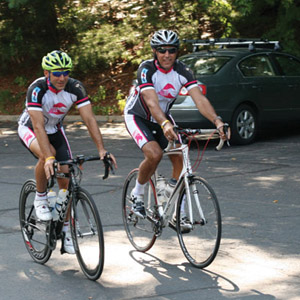
There used to be a glass enclosure inside the office of Southampton, Pa.-basedAlderson Engineering. It contained a necktie.
“It said, ‘In case of meeting, break glass,’” Alderson Engineering President and CEOHoward Alderson, P.E., explains.
Formal dress is not high on the priority list at Alderson Engineering. On a recent June day, employees decked out in blue jeans and print T-shirts were fast at work in the company’s open layout.
“We’re casual unless there is a high-level meeting taking place,” Alderson says.
That dress code ties into the company’s progressive philosophy regarding the use of sustainable technologies in its projects.
“We want to attract employees who share the same philosophy who are interested in advancing the technology of buildings,” Alderson notes. “The workplace doesn’t have to be a stuffy environment. We encourage people to explore new things and go out on a limb a little bit. We test the waters with new technologies so everybody is comfortable with the technology before we design it into a project. To promote that kind of work environment you have to be a little different. Casualness is welcomed by everybody.”
Venturing Out
Alderson, a graduate of Drexel University, previously was a partner in a Philadelphia engineering firm. After a decade there, Alderson decided it was time to fly solo and Alderson Engineering was born. The firm ran out of Alderson’s home for the first four years and has been at its current location for the last 16 years. Alderson Engineering now has a roster of 18 employees (15 engineers), one of which is Howard Alderson’s 29-year-old son,Travis Alderson, P.E., LEED AP, CBCP.The younger Alderson, a University of Pittsburgh product, and the firm’s vice president of engineering and director of sustainability, recalls delving into the family business at a young age.
“I can remember being 6 or 7 and making blueprints for my dad,” says Travis Alderson, the youngest of three children (his siblings are both in the medical field). “I worked here throughout high school filing and making blueprints and doing some CAD work. I did a co-op here every summer through my college career.”
Howard Alderson has seen his son grow from a young child sitting at a drawing board in the family’s basement to a successful engineer well versed in all things energy efficient.
“He would come home from school and would sit in the corner of the office and do his homework. I would give him a drawing board when we still had drawing boards and he would sit there and draw,” Howard Alderson says. “He’s grown up in the business. I am grooming him at some point to take over the business. Travis has come a long way. He’s become a very good engineer.”
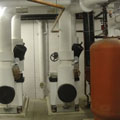
Green Going Way Back
One of Alderson Engineering’s specialties in the realm of green technology is the use of geothermal heating and cooling. A trip to Waco, Texas, in the 1980s set the geothermal ball in motion for Howard Alderson.“When I was a partner in the other firm, I stumbled by accident on geothermal technology while inspecting a project in Texas,” Howard Alderson says. “I went into a factory in Waco and the president of the company introduced me to the geothermal system. He said they were experimenting with it there. On the plane ride back, I kept thinking about it. When I got back, I called him and he told me about two guys in Fort Wayne who were buying his equipment. Those two were the founders of Water Furnace. I got to know them and started sharing information. I’ve been designing geothermal systems ever since.”
Geothermal is just one of a number of tricks in Alderson Engineering’s bag of sustainable tricks.
“People have become a lot more interested in energy efficiency,” Howard Alderson says. “The LEED process has given building owners a better awareness in green technologies. We started based on people wanting energy-efficient and green buildings. Graywater, rainwater systems, solar hot water heating and photovoltaic electrical production are things our clients welcome. Those that meet the client’s criteria are implemented in the design of the building. We don’t get a lot of pushback from clients that these systems are too technical or are too hard to maintain.”
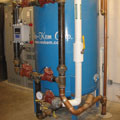
Full Flexibility
Two of Alderson Engineering’s recent larger sustainable projects include theVertical Screenoffice building in Warminster, Pa., and the New Kensington CAPA High School campus in Philadelphia. The New Kensington school is a LEED Platinum-certified building and Vertical Screen is on track to earn Platinum certification.The Vertical Screen building, home to an applicant screening company, sits on the old Johnsville Naval Air Station. Johnsville NAS was one of many naval sites that contributed resources to the Apollo Space Program in the 1960s. The $15 million Vertical Screen project took six months to design and 12 months to build.
“The client is probably one of the best you could have as an engineer,” Travis Alderson says. “They gave us ultimate flexibility and really pushed the design team to be as creative and outside the box as you could be. Erdy McHenry Architecture was the architect and they share the same philosophies as our company does. Their buildings don’t look like anybody else’s.”
Geothermal is at the forefront of green systems in the building, which is shaped like an airplane hangar and features a curved roof. The geothermal system contains 64 boreholes, each 500 feet deep.
“The Vertical Screen project had a very progressive client,” Howard Alderson states. “They said the sky was the limit and they were not afraid to pay for the best and most efficient technology. You do not get clients like that all the time. It was a treat for everybody to let their minds go and come up with the most creative ideas and we did. It has just about everything in it.”
A water-to-water heat pump generates hot water to provide space heating via fin-tube radiation and generates domestic hot water via indirect water heaters. Combination water-to-air heat pumps are used for space conditioning (heating and cooling).
“In the summertime we’re using the reclaimed heat,” Travis Alderson states. “The heat gained through the building goes through the heat pump system to heat the domestic hot water that goes into the domestic hot water storage tanks.”
The building is realizing significant energy savings thanks in part to some creative thinking with the water-to-water heat pumps.
“Water-to-water heat pumps are capable of producing 130° to 135° heating water,” Alderson Engineering Senior Mechanical EngineerDrew McFaddenexplains. “We had to come up with an energy-efficient way to make domestic hot water but also maintain 140° water in the storage tank, and we were not strangers to utilizing heat pump water heaters. There isn’t an exact product that fits the application so we had to think outside the box.
“After some brainstorming, we took two water heaters with dual heating coils, a heating water coil and an electric coil that normally would be used in a solar hot water application and made domestic hot water using heated water off the geothermal system year-round. You are getting the benefit of 130° water entering into the water heater. You only need to raise the temperature 10° electrically instead of 100° to get to 140°, thereby saving energy by utilizing the heat pump to make hot water. If we ever have a problem arise with the water-to-water heat pump, the electric coils are fully capable of handling the domestic water needs of the building.”
Four dedicated geothermal outside air units with energy recovery provide ventilation to the building.
“We’re fully conditioning the outside air,” Travis Alderson says. “The call center is a 22,000- sq.-ft. open space and has an under-floor air distribution system. Every employee has an under-floor air diffuser at their desk and controls their own environment. Every enclosed office has a water-source heat pump to maintain temperature.”
Toilet flushing uses reclaimed water from the building’s rainwater harvesting system. All bathrooms are equipped with American Standard and Sloan low-flow fixtures.
A building automation system monitors the quantity of reclaimed water used per bathroom and the kilowatt-hours generated from the solar system. This information displays on flat-screen televisions in the building lobby. The building’s energy model predicts energy savings of 52% and a reduction in water consumption of 76.5%.
“They have sensors that can tell at any given time how many flushes per employee per hour are used,” Howard Alderson says. “They plan to use it to save energy and water and to motivate employees with contests to see which team has the lowest utility bill.”
Visitors to the building are able to see MEP equipment through plate-glass windows in the front lobby. All works of art in the building - such as the two-ton chunks of coal used in sculptures - are energy-related.
“The owner is all about energy and all about green technology and made it the focus of the building,” Howard Alderson says.
McFadden is quick to point out the implementation of all the latest and greatest high-tech MEP gadgets into the building was not just for show.
“You have a level and standard of care to deliver to the client,” he says. “We can’t start doing something just because it’s emerging technology. It has to function with the project.”
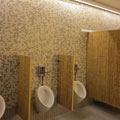
First of its Kind
For New Kensington CAPA High School, Alderson Engineering’s marching orders from BSI Construction and AP Construction were to design at least a LEED Silver campus. It turned out to be a tad higher than that and geothermal again played a key part in the building earning the top-of-the-chart Platinum rating.“The school district has building standards and specifications for every school they build,” Travis Alderson says. “Every school has the same water closet, boiler and chiller. That is what you are required to use, but because this was a turnkey job, we had the flexibility to deviate from the building standard. We wanted to design the first geothermal school for the School District of Philadelphia. We presented the idea to the school district and were able to show them how it will save money for the city and provide a better indoor environment for the students.”
The geothermal system has 100 wells, each 500 feet deep, all located under the school’s football field. Carrier water-to-air-heat pumps fuel the geothermal HVAC system. An Annexair dedicated heat-recovery ventilation system features carbon dioxide demand-based ventilation.
A 30,000-gallon underground storage tank collects rainwater from the gym roof and pumps it into the building through a filtration and water treatment system that treats the water for toilet and urinal flushing as well as irrigation of the campus’ green roofs. Low-flow bathroom fixtures (American Standard and Sloan) contribute to further savings.
All the MEP equipment at the school is located inside the building’s envelope -another major plus for the school district.
“It’s an area that is known for vandalism and it was built at a time when copper was being stolen,” Travis Alderson says. “The school district really liked the idea of vandal-proofing the MEP systems. There are no chillers, rooftop units, boilers or cooling towers outside on grade or on the roof. Everything is hidden.”
Travis Alderson projects the sustainable features will result in a 33.4% reduction in energy costs (roughly $100,000 a year), and the use of low-flow fixtures and the rainwater system will result in a 64% reduction in water consumption for the school district.
The school is believed to be the first LEED Platinum high school in the country.
“They are saving energy and they are saving water and the indoor air environment in the school is precise,” Howard Alderson says. “They don’t have the typical complaints of it being too hot or too cold or too humid. We addressed all of that in the design of the system so each classroom gets individual heating, cooling and ventilation and dehumidification controls. It’s ‘set it and forget it’ technology. The school district is very happy.”
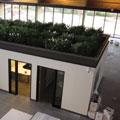
A Green Office
Green isn’t only limited to the projects Alderson Engineering works on. Back at headquarters, the company has a locker room that employees utilize before and after fitness activities. Numerous employees ride bikes to work or simply go out for a bike ride or a run at lunchtime.“A lot of employees stay active running, biking, swimming and competing in triathlons,” Travis Alderson says. “We encourage a healthy lifestyle inside and outside the office.”
Howard Alderson adds: “It gives you a chance during the day to blow off steam and reset your thought process. The Vertical Screen project is right down the road from our office. Some of us literally ran or biked over there to watch the progress.”
Fostering a proactive and progressive working environment has led to a win-win situation for the firm.
“We are very small-scale. You have to stay ahead of the times,” Howard Alderson says. “We have a very casual, friendly and social atmosphere here. When people are on deadline, others stop what they are doing to pitch in. We encourage mechanical engineers to do work on electrical designs when they are so moved. The cross-pollination of technology is good. When one person is going to a construction meeting, they are well-versed in the mechanical and electrical systems to the point they can understand a field question or condition and solve it there.”
As Travis Alderson points out, engineers working in a progressive setting with progressive technologies and ideas tend to produce results today’s clients are looking for.
“Our goal is to have happy and productive employees,” he says. “What is good for our employees is good for our business and clients. When people are in the office they are being creative and the client is getting the best possible product.”
